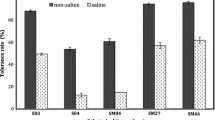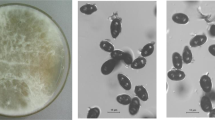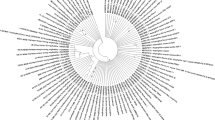Abstract
The present study investigated the efficiency of Aspergillus sydowii strain bpo1 (GenBank Accession Number: MK373021) in the removal of anthracene (100 mg/L). Optimal degradation efficiency (98.7%) was observed at neutral pH, temperature (30°C), biomass weight (2 g) and salinity (0.2% w/v) within 72 h. The enzyme analyses revealed 131%, 107%, and 89% induction in laccase, lignin peroxidase, and manganese peroxidase respectively during anthracene degradation. Furthermore, the degradation efficiency (99.8%) and enzyme induction were significantly enhanced with the addition of 100 mg/L of citric acid and glucose to the culture. At varying anthracene concentrations (100–500 mg/L), the degradation rate constants (k1) peaked with increasing concentration of anthracene while the half-life (t1/2) decreases with increase in anthracene concentration. Goodness of fit (R2 = 0.976 and 0.982) was observed when the experimental data were subjected to Langmuir and Temkin models respectively which affirmed the monolayer and heterogeneous nature exhibited by A. sydwoii cells during degradation. Four distinct metabolites; anthracene-1,8,9 (2H,8aH,9aH)-trione, 2,4a-dihydronaphthalene-1,5-dione, 1,3,3a,7a-tetrahydro-2-benzofuran-4,7-dione and 2-hydroxybenzoic acid was obtained through Gas Chromatography-Mass spectrometry (GC-MS). A. sydowii exhibited promising potentials in the removal of PAHs.

Similar content being viewed by others
References
Al-Hawash A B, Zhang X, Ma F (2019). Removal and biodegradation of different petroleum hydrocarbons using the filamentous fungus Aspergillus sp. RFC-1. MicrobiologyOpen, 8(1): e00619
Alva V A, Peyton B M (2003). Phenol and catechol biodegradation by the haloalkaliphile Halomonas campisalis: influence of pH and salinity. Environmental Science & Technology, 37(19): 4397–4402
Ambrosoli R, Petruzzelli L, Luis Minati J, Ajmone Marsan F (2005). Anaerobic PAH degradation in soil by a mixed bacterial consortium under denitrifying conditions. Chemosphere, 60(9): 1231–1236
Arun A, Raja P P, Arthi R, Ananthi M, Kumar K S, Eyini M (2008). Polycyclic aromatic hydrocarbons (PAHs) biodegradation by basidiomycetes fungi, Pseudomonas isolate, and their cocultures: comparative in vivo and in silico approach. Applied Biochemistry and Biotechnology, 151(2–3): 132–142
Balachandran C, Duraipandiyan V, Balakrishna K, Ignacimuthu S (2012). Petroleum and polycyclic aromatic hydrocarbons (PAHs) degradation and naphthalene metabolism in Streptomyces sp. (ERI-CPDA-1) isolated from oil contaminated soil. Bioresource Technology, 112: 83–90
Baltrons O, Lopez-Mesas M, Vilaseca M, Gutierrez-Bouzan C, Le Derf F, Portet-Koltalo F, Palet C (2018). Influence of a mixture of metals on PAHs biodegradation processes in soils. Science of the Total Environment, 628–629: 150–158
Bankole P O, Adekunle A A, Govindwar S P (2018). Enhanced decolorization and biodegradation of Acid Red 88 dye by newly isolated fungus, Achaetomium strumarium. Journal of Environmental Chemical Engineering, 6(2): 1589–1600
Birolli W G, de ASantos D, Alvarenga N, Garcia A C F S, Romao L P C, Porto A L M (2018). Biodegradation of anthracene and several PAHs by the marine derived fungus Cladosporium sp. CBMAI 1237. Marine Pollution Bulletin, 129: 525–533
Bogan B W, Lamar R T (1996). Polycyclic aromatic hydrocarbon degrading capabilities of Phanerochaete laevis HHB-1625 and its extracellular ligninolytic enzymes. Applied and Environmental Microbiology, 62(5): 1597–1603
Cao H, Wang C, Liu H, Jia W, Sun H (2020). Enzyme activities during Benzo[a] pyrene degradation by the fungus Lasiodiplodia theobromae isolated from a polluted soil. Scientific Reports, 10(1): 865
Capotorti G, Cesti P, Lombardi A, Guglielmetti G (2005). Formation of sulfate conjugates metabolites in the degradation of phenanthrene, anthracene, pyrene and benzo[a]pyrene by the ascomycete Aspergillus terreus. Polycyclic Aromatic Compounds, 25(3): 197–213
Cerniglia C E (1997). Fungal metabolism of polycyclic aromatic 1424 hydrocarbons: past, present and future applications in 1425 bioremediation. Journal of Industrial Microbiology and Biotechnology, 19(5–6): 324–333
Cerniglia C E, Sutherland J B (2010). Degradation of polycyclic aromatic hydrocarbons by fungi. In: Timmis K, editor. Handbook of Hydrocarbon and Lipid Microbiology. Berlin-Heidelberg: Springer, 2079–2110
Collins P J, Kotterman M J J, Field J A, Dobson A D W (1996). Oxidation of anthracene and benzo[a]pyrene by laccases from Trametes versicolor. Applied and Environmental Microbiology, 62(12): 4563–4567
Doyle J J (1990). Isolation of plant DNA from fresh tissue. Focus (San Francisco, Calif.), 12: 13–15
Gong B, Wu P, Ruan B, Zhang Y, Lai X, Yu L, Li Y, Dang Z (2018). Differential regulation of phenanthrene biodegradation process by kaolinite and quartz and the underlying mechanism. Journal of Hazardous Materials, 349: 51–59
Hadibarata T, Kristanti R A (2014). Potential of a white-rot fungus Pleurotus eryngii F032 for degradation and transformation of fluorene. Fungal Biology, 118(2): 222–227
Hammel K E, Green B, Gai W Z (1991). Ring fission of anthracene 1611 by a eukaryote. Proceedings of the National Academy of Sciences of the United States of America, 88(23): 10605–10608
Hwang H M, Hu X, Zhao X (2007). Enhanced bioremediation of polycyclic aromatic hydrocarbons by environmentally friendly techniques. Journal of Environmental Science and Health, 25: 313–352
Ike P T L, Birolli W G, dos Santos D M, Porto A L M, Souza D H F (2019). Biodegradation of anthracene and different PAHs by a yellow laccase from Leucoagaricus gongylophorus. Environmental Science and Pollution Research International, 26(9): 8675–8684
Jacques R J S, Okeke B C, Bento F M, Teixeira A S, Peralba M C R, Camargo F A O (2008). Microbial consortium bioaugmentation of a polycyclic aromatic hydrocarbons contaminated soil. Bioresource Technology, 99(7): 2637–2643
Jacques R J S, Santos E C, Bento F M, Peralba M C R, Selbach P A, Sa E L S, Camargo F A O (2005). Anthracene biodegradation by Pseudomonas sp. isolated from a petrochemical sludge land farming site. International Biodeterioration & Biodegradation, 56(3): 143–150
Juang R S, Wu F C, Tseng R L (1996). Adsorption isotherms of phenolic compounds from aqueous solution onto activated carbon fibers. Journal of Chemical & Engineering Data, 41(3): 487–492
Kumar S, Stecher G, Li M, Knyaz C, Tamura K (2018). MEGA X: Molecular evolutionary genetics analysis across computing platforms. Molecular Biology and Evolution, 35(6): 1547–1549
Majcherczyk A, Johannes C, Hüttermann A (1998). Oxidation of polycyclic aromatic hydrocarbons (PAH) by laccase of Trametes versicolor. Enzyme and Microbial Technology, 22(5): 335–341
Müller R, Antranikian G, Maloney S, Sharp R (1998). Thermophilic degradation of environmental pollutants. In Biotechnology of Extremophiles. Part of Advances in Biochemical Engineering/Biotechnology, 61: 155–169
Punnapayak H, Prasongsuk S, Messner K, Danmek K, Lotrakul P (2009). Polycyclic aromatic hydrocarbons (PAHs) degradation by laccase from a tropical white rot fungus Ganoderma lucidum. African Journal of Biotechnology, 8(21): 5897–5900
Ramadass K, Megharaj M, Venkateswarlu K, Naidu R (2016). Soil bacterial strains with heavy metal resistance and high potential in degrading diesel oil and n-alkanes. International Journal of Environmental Science and Technology, 13(12): 2863–2874
Rashid M I, Mujawar L H, Shahzad T, Almeelbi T, Ismail I M, Oves M (2016). Bacteria and fungi can contribute to nutrients bioavailability and aggregate formation in degraded soils. Microbiology Research, 183: 26–41
Samanta S K, Singh O V, Jain R K (2002). Polycyclic aromatic hydrocarbons: environmental pollution and bioremediation. Trends in Biotechnology, 20(6): 243–248
Santos E C, Jacques R J S, Bento F M, Peralba M C R, Selbach P A, Sá E L S, Cameroon F A O (2008). Anthracene biodegradation and surface activity by an iron-stimulated Pseudomonas sp. Bioresource Technology, 99(7): 2644–2649
Su X M, Bamba A M, Zhang S, Zhang Y G, Hashmi M Z, Lin H J, Ding L X (2018). Revealing potential functions of VBNC bacteria in polycyclic aromatic hydrocarbons biodegradation. Letters in Applied Microbiology, 66(4): 277–283
Tamura K, Nei M (1993). Estimation of the number of nucleotide substitutions in the control region of mitochondrial DNA in humans and chimpanzees. Molecular Biology and Evolution, 10: 512–526
Ting W T E, Yuan S Y, Wu S D, Chang B V (2011). Biodegradation of phenanthrene and pyrene by Ganoderma lucidum. International Biodeterioration & Biodegradation, 65(1): 238–242
Villemain D, Guiraud P, Bordjiba O, Steiman R (2006). Biotransformation of anthracene and fluoranthene by Absidia fusca Linnemann. Electronic Journal of Biotechnology, 9(2): 107–116
Wang C, Sun H, Li J, Li Y, Zhang Q (2009).Enzyme activities during degradation of polycyclic aromatic hydrocarbons by white rot fungus Phanerochaete chrysosporium in soils. Chemosphere, 77: 733–738
Wen X, Jia Y, Li J (2009). Degradation of tetracycline and oxytetracycline by crude lignin peroxidase prepared from Phanerochaete chrysosporium white rot fungus. Chemosphere, 75(8): 1003–1007
Wu Y, Xu Y, Zhou N (2020). A newly defined dioxygenase system from Mycobacterium vanbaalenii PYR-1 endowed with an enhanced activity of dihydroxylation of high-molecular-weight polyaromatic hydrocarbons. Frontiers of Environmental Science and Engineering, 14(1): 14.
Ye J, Yin H, Qiang J, Peng H, Qin H, Zhang N, He B (2011). Biodegradation of anthracene by Aspergillus fumigatus. Journal of Hazardous Materials, 185(1): 174–181
Yuan S Y, Chang B V (2007). Anaerobic degradation of five polycyclic aromatic hydrocarbons from river sediment in Taiwan. Journal of Environmental Science and Health, Part B: Pesticides, Food contaminants and Agricultural wastes, 42(1): 63–69
Zhang J H, Xue Q H, Gao H, Ma X, Wang P (2016). Degradation of crude oil by fungal enzyme preparations from Aspergillus spp. For potential use in enhanced oil recovery. Journal of Chemical Technology and Biotechnology (Oxford, Oxfordshire), 91(4): 865–875
Zhang X X, Cheng S P, Zhu C J, Sun S L (2006). Microbial PAH degradationin soil: degradation pathways and contributing factors. Pedosphere, 16(5): 555–565
Zheng Z, Obbard J P (2002). Removal of surfactant solubilized polycyclic aromatic hydrocarbons by Phanerochaete chrysosporium in a rotating biological contactor reactor. Journal of Biotechnology, 96(3): 241–249
Acknowledgements
Bankole Paul Olusegun hereby thank the Association of Commonwealth Universities (ACU) for the 2019 Blue Charter Award.
Author information
Authors and Affiliations
Additional information
Highlights
• A. sydowii strain bpo1 exhibited 99.8% anthracene degradation efficiency.
• Four unique metabolic products were obtained after anthracene degradation.
• Ligninolytic enzymes induction played vital roles in the removal of anthracene.
• Laccase played a crucial role in comparison with other enzymes induced.
Supporting Materials
Rights and permissions
About this article
Cite this article
Bankole, P.O., Semple, K.T., Jeon, BH. et al. Enhanced enzymatic removal of anthracene by the mangrove soil-derived fungus, Aspergillus sydowii BPOI. Front. Environ. Sci. Eng. 14, 113 (2020). https://doi.org/10.1007/s11783-020-1292-3
Received:
Revised:
Accepted:
Published:
DOI: https://doi.org/10.1007/s11783-020-1292-3




